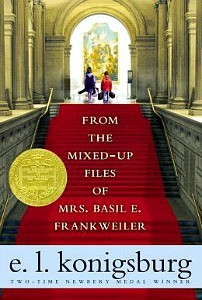
Find more great Horn Book content at these links:
Recommended books: reviews and themed booklists
App and e-book reviews
Movie reviews
Event news and recaps
Events calendar
From the mixed-up lost and found of the Metropolitan Museum of Art: Mixed-Up Files at 50
At the end of From the Mixed-Up Files of Mrs.
 At the end of From the Mixed-Up Files of Mrs. Basil E. Frankweiler, a museum guard reports that a violin case and a trumpet case, containing gray-washed underwear and a transistor radio, have been found in the Metropolitan Museum of Art’s lost and found. “No one has claimed them yet.”
At the end of From the Mixed-Up Files of Mrs. Basil E. Frankweiler, a museum guard reports that a violin case and a trumpet case, containing gray-washed underwear and a transistor radio, have been found in the Metropolitan Museum of Art’s lost and found. “No one has claimed them yet.”Yet is a good word to use in a last line, because it sets readers to wondering. Might the Kincaids (Claudia now a cruise director, Jamie a banker or maybe a politician) still get nostalgic and come back for their belongings? If you happened to visit the museum yourself, might you run into them?
If you follow that line of thinking for too long, imagination runs up against practicalities. Museums don’t keep lost-and-found items for fifty years. Adults don’t take time out of their busy schedules to retrieve their shoddy childhood laundry, even if it’s that laundry’s fiftieth anniversary. And it’s almost impossible to imagine two runaway kids, whose pictures are in the paper, hiding in a public place. Maybe some of E. L. Konigsburg’s details were more plausible in 1967 than they would be now; maybe security systems were easier to fool, and elementary kids walking around on their own in New York City, at least in the daytime, weren’t unusual. Still, Mixed-Up Files is best read with one’s disbelief suspended.
 But fanciful as the premise is, there’s so much that’s real in the book. Konigsburg excels at illustrating little details of human nature, of what being a person is like. The way “ideas drift like clouds in an undecided breeze” just before falling asleep. (Don't try to think about anything too organized at that time!) The way days can feel like months when those days are out of the ordinary. The way two people on the same adventure can have completely different, equally firm ideas of the experience they want to have, and the way they can become a team despite that difference.
But fanciful as the premise is, there’s so much that’s real in the book. Konigsburg excels at illustrating little details of human nature, of what being a person is like. The way “ideas drift like clouds in an undecided breeze” just before falling asleep. (Don't try to think about anything too organized at that time!) The way days can feel like months when those days are out of the ordinary. The way two people on the same adventure can have completely different, equally firm ideas of the experience they want to have, and the way they can become a team despite that difference.Most of the book’s insights, of course, come from the mouth of — er, from the typewriter of — Mrs. Frankweiler herself. It’s not often a good idea to have an adult character narrate a middle-grade novel, of course. But this adult lets Claudia and Jamie remain the center of the story, so much so that the reader can sometimes forget who’s telling it.
Because if anyone’s ever excelled at making the unconventional or implausible utterly believable, it’s E. L. Konigsburg.

RELATED
RECOMMENDED
ALREADY A SUBSCRIBER? LOG IN
We are currently offering this content for free. Sign up now to activate your personal profile, where you can save articles for future viewing.






Add Comment :-
Comment Policy:
Comment should not be empty !!!
Susan Golden
I reread this recently and loved it so much. In fact, all her books are pretty wonderful, especially the last few.Posted : Dec 12, 2017 07:10